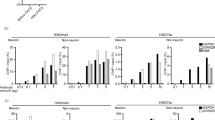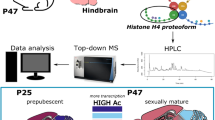Abstract
Histone acetylation plays a role in the regulation of gene transcription. Yet it is not known whether post-mortem brain tissue is suitable for the analysis of histone acetylation. To examine this question, nucleosomes were isolated from frontal cortex of nine subjects which were obtained at short times after death and immediately frozen at −80°C or maintained at room temperature from 3 h up to 50 h after death and then frozen at −80°C to mimic variable post-mortem delay in tissue processing as currently occurs in normal practice. Chromatin immunoprecipitation assays were performed for two lysine residues, H3K9ac and H3K27ac. Four gene loci were amplified by SyBrGreen PCR: Adenosine A2A receptor, UCHL1, α-synuclein and β-globin. Results showed variability in the histone acetylation level along the post-mortem times and an increase in the acetylation level at an unpredictable time from one case to another and from one gene to another within the first 24 h of post-mortem delay. Similar results were found with three rat brains used to exclude the effects of agonal state and to normalize the start-point as real time zero. Therefore, the present observations show that human post-mortem brain is probably not suitable for comparative studies of histone acetylation.



Similar content being viewed by others
References
Alarcón JM, Malleret G, Touzani K et al (2004) Chromatin acetylation, memory, and LTP are impaired in CBP+/− mice: a model for the cognitive deficit in Rubinstein-Taybi syndrome and its amelioration. Neuron 42:947–959
Allfrey VG, Faulkner R, Mirsky AE (1964) Acetylation and methylation of histones and their possible role in the regulation of RNA synthesis. Proc Natl Acad Sci USA 51:786–794
Barrachina M, Ferrer I (2009) DNA methylation of Alzheimer disease and tauopathy-related genes in postmortem brain. J Neuropathol Exp Neurol 68:880–891
Barrachina M, Castaño E, Ferrer I (2006) TaqMan PCR assay in the control of RNA normalization in human post-mortem brain tissue. Neurochem Int 49:276–284
Barski A, Cuddapah S, Cui K et al (2007) High-resolution profiling of histone methylations in the human genome. Cell 129:823–837
Biagioli M, Pinto M, Cesselli D et al (2009) Unexpected expression of alpha- and beta-globin in mesencephalic dopaminergic neurons and glial cells. Proc Natl Acad Sci USA 106:15454–15459
Braak H, Alafuzoff I, Arzberger T et al (2006) Staging of Alzheimer disease-associated neurofibrillary pathology using paraffin sections and immunocytochemistry. Acta Neuropathol 112:389–404
Buesa C, Maes T, Subirada F et al (2004) DNA chip technology in brain banks: confronting a degrading world. J Neuropathol Exp Neurol 63:1003–1014
Butler R, Bates GP (2006) Histone deacetylase inhibitors as therapeutics for polyglutamine disorders. Nat Rev Neurosci 7:784–796
Calon F, Dridi M, Hornykiewicz O et al (2004) Increased adenosine A2A receptors in the brain of Parkinson’s disease patients with dyskinesias. Brain 127:1075–1084
Cheung P, Allis CD, Sassone-Corsi P (2000) Signaling to chromatin through histone modifications. Cell 103:263–271
Chiba-Falek O, Touchman JW, Nussbaum RL (2003) Functional analysis of intra-allelic variation at NACP-Rep1 in the alpha-synuclein gene. Hum Genet 113:426–431
Crecelius A, Götz A, Arzberger T et al (2008) Assessing quantitative post-mortem changes in the gray matter of the human frontal cortex proteome by 2-D DIGE. Proteomics 8:1276–1291
De los Santos M, Zambrano A, Aranda A (2007) Combined effects of retinoic acid and histone deacetylase inhibitors on human neuroblastoma SH-SY5Y cells. Mol Cancer Ther 6:1425–1432
Durrenberger PF, Fernando S, Kashefi SN et al (2010) Effects of antemortem and postmortem variables on human brain mRNA quality: a BrainNet Europe study. J Neuropathol Exp Neurol 69:70–81
Faraco G, Pancani T, Formentini L et al (2006) Pharmacological inhibition of histone deacetylases by suberoylanilide hydroxamic acid specifically alters gene expression and reduces ischemic injury in the mouse brain. Mol Pharmacol 70:1876–1884
Ferrer I, Armstrong J, Capellari S et al (2007a) Effects of formalin fixation, paraffin embedding, and time of storage on DNA preservation in brain tissue: a BrainNet Europe study. Brain Pathol 17:297–303
Ferrer I, Santpere G, Arzberger T et al (2007b) Brain protein preservation largely depends on the postmortem storage temperature: implications for study of proteins in human neurologic diseases and management of brain banks: a BrainNet Europe Study. J Neuropathol Exp Neurol 66:35–46
Ferrer I, Martinez A, Boluda S et al (2008) Brain banks: benefits, limitations and cautions concerning the use of post-mortem brain tissue for molecular studies. Cell Tissue Bank 9:181–194
Fischer A, Sananbenesi F, Wang X et al (2007) Recovery of learning and memory is associated with chromatin remodelling. Nature 447:178–182
Forsberg EC, Downs KM, Christensen HM et al (2000) Developmentally dynamic histone acetylation pattern of a tissue-specific chromatin domain. Proc Natl Acad Sci USA 97:14494–14499
Fountoulakis M, Hardmeier R, Höger H et al (2001) Postmortem changes in the level of brain proteins. Exp Neurol 167:86–94
Govindarajan N, Agis-Balboa RC, Walter J et al (2011) Sodium butyrate improves memory function in an Alzheimer’s disease mouse model when administered at an advanced stage of disease progression. J Alzheimers Dis May 13. [Epub ahead of print]
Guan JS, Haggarty SJ, Giacometti E et al (2009) HDAC2 negatively regulates memory formation and synaptic plasticity. Nature 459:55–60
Hebbes TR, Thorne AW, Crane-Robinson C (1988) A direct link between core histone acetylation and transcriptionally active chromatin. EMBO J 7:1395–1402
Heintzman ND, Hon GC, Hawkins RD et al (2009) Histone modifications at human enhancers reflect global cell-type-specific gene expression. Nature 459:108–112
Herman D, Jenssen K, Burnett R et al (2006) Histone deacetylase inhibitors reverse gene silencing in Friedreich’s ataxia. Nat Chem Biol 2:551–558
Hogarth P, Lovrecic L, Krainc D (2007) Sodium phenylbutyrate in Huntington’s disease: a dose-finding study. Mov Disord 22:1962–1964
Huang HS, Matevossian A, Jiang Y (2006) Chromatin immunoprecipitation in postmortem brain. J Neurosci Methods 156:284–292
Hunsucker SW, Solomon B, Gawryluk J et al (2008) Assessment of post-mortem-induced changes to the mouse brain proteome. J Neurochem 105:725–737
Jenuwein T, Allis CD (2001) Translating the histone code. Science 293:1074–1080
Kretzschmar H (2009) Brain banking: opportunities, challenges and meaning for the future. Nat Rev Neurosci 10:70–78
Larsen CN, Krantz BA, Wilkinson KD (1998) Substrate specificity of de-ubiquitinating enzymes: ubiquitin C-terminal hydrolases. Biochemistry 37:3358–3368
Lee BM, Mahadevan LC (2009) Stability of histone modifications across mammalian genomes: implications for ‘epigenetic’ marking. J Cell Biochem 108:22–34
Levenson JM, O’Riordan KJ, Brown KD et al (2004) Regulation of histone acetylation during memory formation in the hippocampus. J Biol Chem 279:40545–40559
Luger K, Mäder AW, Richmond RK et al (1997) Crystal structure of the nucleosome core particle at 2.8 A resolution. Nature 389:251–260
Monoranu CM, Grünblatt E, Bartl J et al (2010) Methyl- and acetyltransferases are stable epigenetic markers post-mortem. Cell Tissue Bank Jul 23 [Epub ahead of print]
Monti B, Gatta V, Piretti F et al (2010) Valproic acid is neuroprotective in the rotenone rat model of Parkinson’s disease: involvement of alpha-synuclein. Neurotox Res 17:130–141
Peleg S, Sananbenesi F, Zovoilis A et al (2010) Altered histone acetylation is associated with age-dependent memory impairment in mice. Science 328:753–756
Ren M, Leng Y, Jeong M et al (2004) Valproic acid reduces brain damage induced by transient focal cerebral ischemia in rats: potential roles of histone deacetylase inhibition and heat shock protein induction. J Neurochem 89:1358–1367
Richter F, Meurers BH, Zhu C et al (2009) Neurons express hemoglobin alpha- and beta-chains in rat and human brains. J Comp Neurol 515:538–547
Ricobaraza A, Cuadrado-Tejedor M, Pérez-Mediavilla A (2009) Phenylbutyrate ameliorates cognitive deficit and reduces tau pathology in an Alzheimer’s disease mouse model. Neuropsychopharmacology 34:1721–1732
Rosenfeld JA, Wang Z, Schones DE et al (2009) Determination of enriched histone modifications in non-genic portions of the human genome. BMC Genomics 10:143
Schnell S, Mendoza C (1997) Enzymological considerations for a theoretical description of the quantitative competitive polymerase chain reaction (QC-PCR). J Theor Biol 184:433–440
Sköld K, Svensson M, Norrman M et al (2007) The significance of biochemical and molecular sample integrity in brain proteomics and peptidomics: stathmin 2-20 and peptides as sample quality indicators. Proteomics 7:4445–4456
Solano SM, Miller DW, Augood SJ et al (2000) Expression of alpha-synuclein, parkin, and ubiquitin carboxy-terminal hydrolase L1 mRNA in human brain: genes associated with familial Parkinson’s disease. Ann Neurol 47:201–210
Stadler F, Kolb G, Rubusch L et al (2005) Histone methylation at gene promoters is associated with developmental regulation and region-specific expression of ionotropic and metabotropic glutamate receptors in human brain. J Neurochem 94:324–336
Strahl BD, Allis CD (2000) The language of covalent histone modifications. Nature 403:41–45
Touchman JW, Dehejia A, Chiba-Falek O et al (2001) Human and mouse alpha-synuclein genes: comparative genomic sequence analysis and identification of a novel gene regulatory element. Genome Res 11:78–86
Wang Z, Zang C, Rosenfeld JA et al (2008) Combinatorial patterns of histone acetylations and methylations in the human genome. Nat Genet 40:897–903
Zhao TC, Cheng G, Zhang LX et al (2007) Inhibition of histone deacetylases triggers pharmacologic preconditioning effects against myocardial ischemic injury. Cardiovasc Res 76:473–481
Acknowledgments
We are grateful to Dr. Akbarian and Dr. Huang for nucleosomes isolation protocol as well as helpful comments for ChIP to Input ratio determination. We thank T. Yohannan for editorial assistance. This study was funded by grants from the Ministerio de Ciencia e Innovación, Instituto de Salud Carlos III (CP08/00095 to MB; PI08/0582 to IF), the European Commission under the Sixth Framework Programme (BrainNet Europe II, LSHM-CT-2004-503039) to IF and the Fundació La Marató de TV3 (092330) to MB. IVM is a recipient of an IDIBELL predoctoral fellowship.
Author information
Authors and Affiliations
Corresponding author
Electronic supplementary material
Below is the link to the electronic supplementary material.
10561_2011_9278_MOESM1_ESM.pdf
For every specific PCR product in the human artificial post-mortem delays (Fig. 1), the dissociation curve analysis shows lack of formation of primer dimers and unspecific PCR amplifications (DNA: PCR product; NTC: non-template control) (PDF 121 kb)
Rights and permissions
About this article
Cite this article
Barrachina, M., Moreno, J., Villar-Menéndez, I. et al. Histone tail acetylation in brain occurs in an unpredictable fashion after death. Cell Tissue Bank 13, 597–606 (2012). https://doi.org/10.1007/s10561-011-9278-9
Received:
Accepted:
Published:
Issue Date:
DOI: https://doi.org/10.1007/s10561-011-9278-9




